Ellen and Jim Have a Blog, Too
We are two part-time academics. Ellen teaches in the English department and Jim in the IT program at George Mason University.


Cadbury Castle & Glastonbury Abbey · 22 October 05
Dear Fanny,
Prompted by my rereading of Jennifer Wallace’s remarkable Digging the Dirt: The Archaeological Imagination, I return to putting photos of this past summer’s visit to Somerset. The photos are (again) taken by Laura.
At times I’ve been a great reader and dreamer about Arthurian literature, and so too Jim, Laura, and Izzy. Among our books is Leslie Alcock’s Was this Camelot? Excavations at Cadbury Castle, 1966-70, where he argues that the Iron Age fort he and others excavated atop a high hill at Chapel Cross (a small South Cadbury village off a small road off the A303) was the mythic Camelot. We bought the Alcock book around the time we took our first trip to England hunting "sites" sacred to Arthur, and drove it to Glastonbury Abbey (mid-1970s). This time we took with us our old Jacquetta Hawkes’s A Guide to the Prehistoric and Roman Monuments in England and Wales and Geoffrey Ashe’s The Quest for Arthur’s Britain.
We decided we would spend two summer half-days walking around what was left of Cadbury Castle and Glastonbury Abbey.
Our pictures are not as effective as Alcock’s or the the Britannia online Cadbury Castle: King Arthur’s Camelot, and we haven’t got imaginative maps, but perhaps that the point. Somehow we were not as caught up by what we experienced and saw in South Cadbury and Glastonbury as we had been at Stonehenge, Avebury and Stanton Drew. We were not drawn into a landscape in the same way; without the stones to work their magic, we had to work too much or were distracted by what had been done for us.
So this time I’m responding as much to the book I’ve been reading this afternoon as to memory and pictures. Wallace has persuaded me that a lot that passes for archaeological science is imaginative politics and individual history recreation.
When we finally found the small parking lot off the small road by Chapel Cross, near South Cadbury, climbed a long high winding wide be-rocked road (on both sides of which is a thin wood), and got to the top of a high high wide hill, what we saw was a large semi-sunken bowl of land the center of which looked out across the landscape from far and wide:
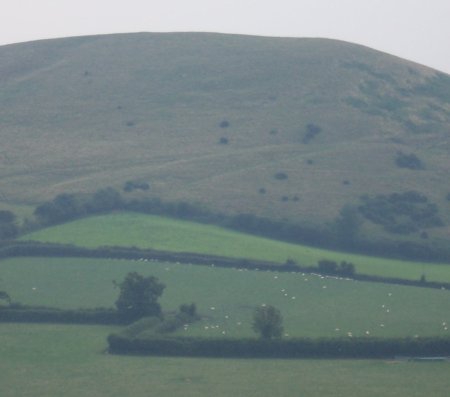
We knew we were at Camelot only because at its center was an iron and stone commemorative pillar which told us so. Nothing visible of Alcock’s excavations could be seen except perhaps for indents along the sides of the hill. The commemorative pillar was necessary for reassurance. It had a round flat surface good for putting tissue boxes and handbags on:
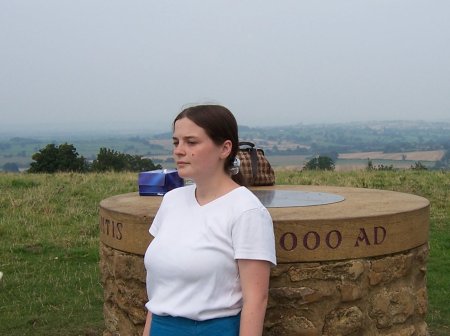
It was a very hot afternoon (really—it was around 3 in the afternoon on a bright intensely sun sultry day)—and I came up to Izzy and shared her water bottle:
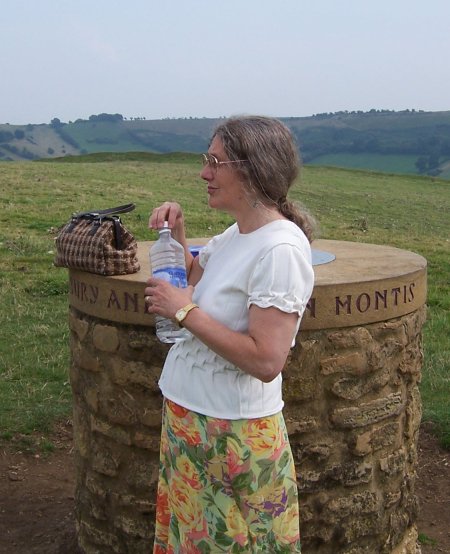
Jim walked about and tried to enable us to imagine where the lines of the fort had been and how the space might have been used to keep animals, for living quarters, and as a effective landmark from which to fight off the invaders:
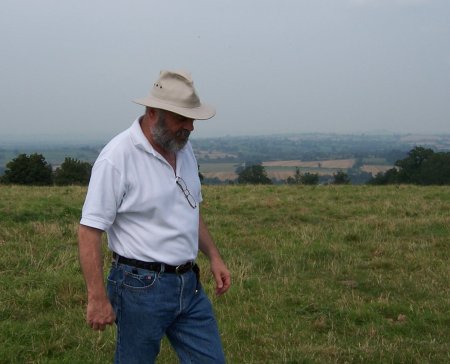
Our version of the story we took from Elizabeth Jenkins’s excellent history book, The Mystery of King Arthur: that is, Arthur and Mordren were a Roman captain and his sidekick making a last stand against the Anglo-Saxons. We filled this out with large dollops of memory from all sorts of texts and pictures of which I’ll mention here just the first few that come to mind: films (Excalibur, Bresson’s Lancelot du Lac, The Fellowship of the Ring), modern novels (Mary Stewart’s, Tolkien), older poems (Chrétien de Troyes, Malory, Tennyson—and Sara Teasdale), older novels (by Walter Scott), Lacy’s Arthurian Encyclopedia, and musicals (Camelot & by Wagner).
We did manage a frisson if only from a faith that such a high place where you could see so much from, if partly by its sheer emptiness, had sustained a past life and people we could not reach:
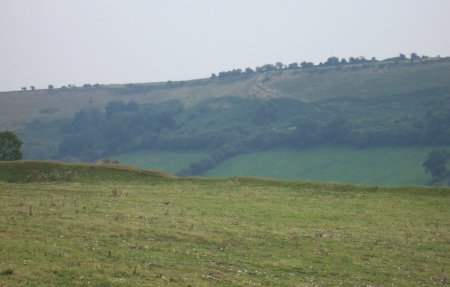
Our feelings were differently affected and then framed when we went to Glastonbury on another morning.
First it was morning and cooler. We also found the place with ease. Instead of a long drive where we were dependent on our Global Positioning Device (Satellite Navigation System) to find an obscure turn in a road, we took a short drive from Wells to the town of Glastonbury. It had changed much since Jim and I had been there in the middle 1970s, and not necessarily for the better. What had been a staid middle class genteel sort of place was now a largish town whose central street was filled with "New Age" shops of kitsch, cards, memorabilia and used clothes. At the center of town were a group of bohemian dressed half-drunken bums (young men and women). We wondered how people made a living in this place outside tourism.
The abbey itself was now closed off by a turnstile. It was inside a compound and you had to walk through a tourist museum (one had to pay much more) to get into the grounds.
Sheer nothingness was not the obstacle; we didn’t object to the cafes (including one inside the grounds), the nearby building where "justice" was once meted out and where there is now an exhibit about the late Victorian excavations; a new Visitor’s Center (also inside the grounds and got up to look like an imagined contemporary eatery complete with plastic food), a lovely lake with ducks where a class of friendly elderly people were drawing. Nonetheless, these present-time activities, values (there were people dressed as monks in the grounds and much paraphernalia inside one building about the Anglican church’s history), people, and evidence of aspirations and dreams weakened or diminished the aura Jim and I remembered experiencing in our 1970s more pristine excursion.
Once you get into the grassy meadow grounds where the remnants of cathedrale and communal life are to be found, you are left (mostly) alone to wander through the ruins themselves.
Here is a large doorway:
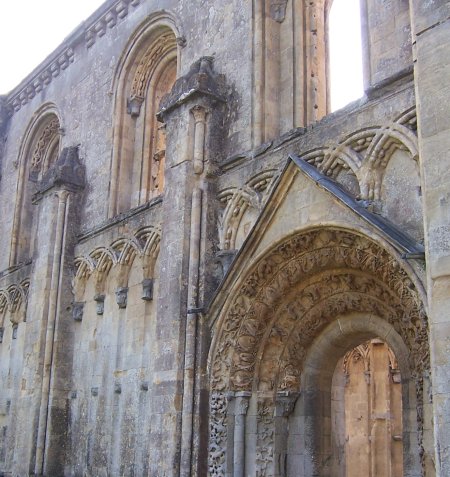
of one of the mass structures you can walk into and around:
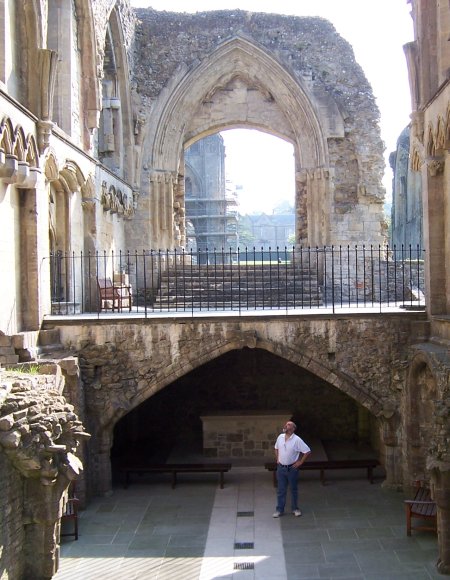
You can’t see it from Laura’s photo, but its windows and walls are reinforced by modern iron:
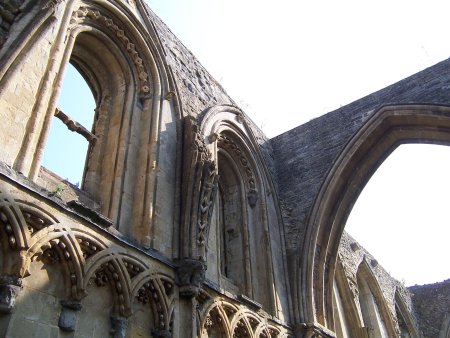
Memory is treacherous, but also stubborn. As we walked up to the large rectangle of sunken landscape around which are ankle-high crumbling walls and some steps, I remembered walking through the space last time. Jim said we were walking along where there had been a refectory:
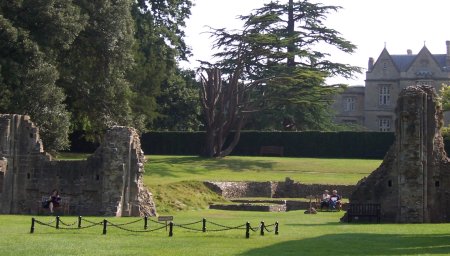
Laura did not take photos of the plaques in the ground telling us that King Arthur was buried here, Queen Guenevere did such-and-such there, or Joseph of Arimathea’s staff was brought somewhere near here. We concentrated on what did give us a sense of awe by its size, age, what we would probably have liked to find more of at Cadbury but did not, as for example these steps:
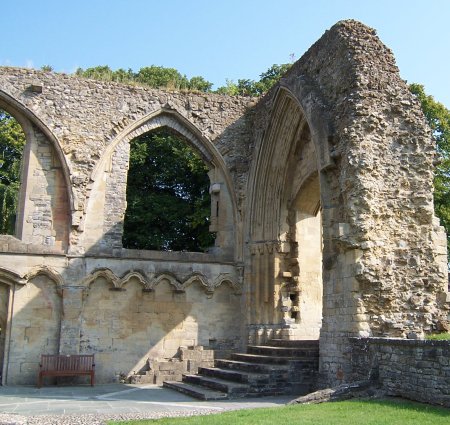
As between the two places, I’m not sure which was the preferable: the one where we were left alone to tell our own story, or the one where we found ourselves confronted by modern fictional reuses about which we were in dispute (especially over "new age" displacements of the modern subcultures of science). As Wallace suggests (though her words are more despairing than my paraphrase), little survives from the past, and hardly anything is sacred. She seems to think objects can be depoliticized and nostalgia itself denuded of particulars of history when "rightly" understood (humanly) meaningful. Myself I think them always potentially dangerous.
What you have do as an individual is try to interpret the distortion you come upon with the texts and pictures your particular memories conjure up.
There was more to see at Glastonbury. We knew we were "there" when we arrived. Glastonbury was more comfortable to be at, and the lake has such beautiful lillies. The grassy landscape was a comfort.
Still for me standing on that hill of the uncertain Camelot pillar I felt more in contact with an imagined past, like we had experienced when we came into contact with the stones and landscapes of neolithic England. Nothing awesomely material (not that I discount the Glastonbury remains), just turf, treading the bare landscape we were trying to read. It could connect to Edward Young’s memorable lines from Night Thoughts (as quoted in Wallace’s book)
Where is the dust that has not been alive?
Chava
--
Posted by: Ellen
* * *
Comment
- Stunning photographs! I’ll have to show these to my husband: maybe we’ll take our next vacation in England. I used to love the Arthurian literature: T. H. White’s charming novel especially, and, of course, I enjoyed the movie, CAMELOT, though I find I can’t watch it any more. Thanks for sharing your impressions and the photos.
— Kathy Oct 23, 11:11am # - Again, I love your photos. But what’s happened to the idea that
Tintagel was Arthur’s castle?
— Bob Oct 23, 3:47pm # - Dear Bob and Kathy,
We’ve never gotten as far as Tintagel. It’s in Cornwall and a drive away from the southeast or north where we’ve lived.
I love listening to Richard Burton’s speaking his songs in Camelot (they’re among my favorites from musicals), but that’s about it from Camelot for me.
Chava
— Chava Oct 24, 12:04am # - The reason I brought it up is that the remains at Tintagel seem much more ancient and thus more Arthurian than those in your photos. I loved my visit there.
— Bob Oct 24, 10:05am # - A splendid tour.
And yet what a fraction in time of our human span separates us from "Arthur."
— R J Keefe Oct 24, 10:41am # - Dear Bob,
On Tintagel: Actually Cadbury Castle is the more ancient. An iron-age fort is said to have been there and was excavated by Alcock. Photos in the book I mentioned "demonstrate" this :)
My theme was, Do we need these physical objects? Do they fool us? How do objects get their aura? Why?
All the while I admit I’d love to go to Kenilworth next.
Chava
— Chava Oct 24, 12:42pm # - Dear RJ,
Yes.
Chava
— Chava Oct 24, 12:43pm #
commenting closed for this article
